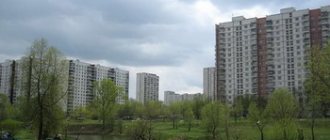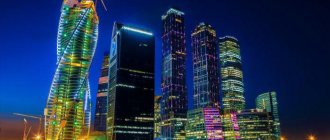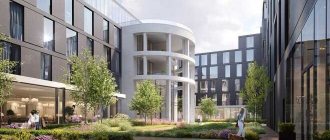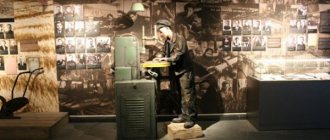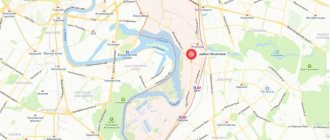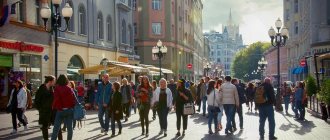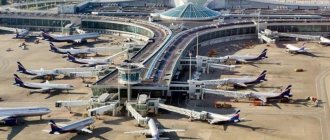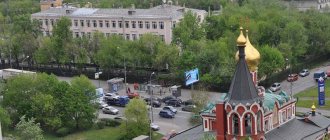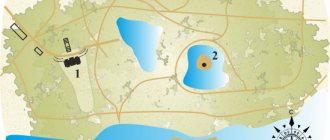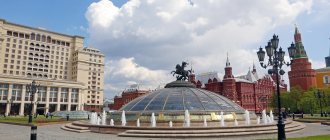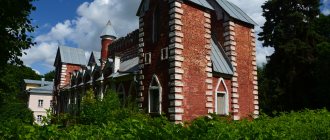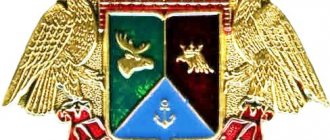Photos of the Begovoy district of Moscow
Educational institutions
schools in the TOP 100 best schools in Moscow in the region.
Rating: TOP 100 best schools in Moscow
Universities of the region:
- Medical College named after. S.P. Botkin
- Russian Medical Academy of Continuing Professional Education
- ANOVO "Moscow International University"
- Institute of Applied Mechanics of the Russian Academy of Sciences
- St. Petersburg School of Television
- Circus School named after. M.N. Rumyantseva (PENCIL)
- Border Academy of the FSB of Russia
Transport accessibility
- Metro – There are no metro stations inside the area. On the neighboring borders there are Begovaya stations - landmark 3 transport ring and Khoroshevskoye Highway, Dynamo and Petrovsky Park not far from each other near the Dynamo stadium. Belorusskaya station is not far from the Belorussky railway station on Leningradsky Prospekt.
- Railway - on the border with the Central Administrative District there is the Belorussky railway station, behind the 3rd transport ring in the Butyrsky district (NEAD) there is the Sovelovsky railway station.
- Bus - bus routes No. 27, 39, T79, 84, 101, 207, 847 operate.
- Trolleybus - routes No. 20, 35, 65.
Begovaya District
During the Time of Troubles, at the beginning of the 17th century, clashes took place here between the troops of the impostor False Dmitry II and Tsar Vasily Shuisky. In 1619, on the Khodynka field, the young Tsar Mikhail Romanov met his father, Patriarch Filaret, after returning from Polish captivity. Catherine II ordered to celebrate the conclusion of the Kyuchuk-Kainardzhi Peace Treaty here, which ended the war with Turkey. But mostly Khodynskoe Field is remembered in connection with the tragedy that happened during the celebration in honor of the coronation of Nicholas II, when more than 1,300 people died in a stampede.
In the eastern part of the Khodynka field, vast undeveloped areas have been preserved, which in the 19th century turned out to be a convenient place for locating large objects. The slaughterhouses of the Zhivodernaya Slobodka, which once existed on the Presnya River, with their bear and hare baiting, were to be replaced by new entertainments that corresponded to the spirit of the times.
The first step in this direction was the Senate decree of March 12, 1831 on the transfer of 120 acres of land to the Horse Racing Society, which began to create an extensive arena for equestrian competitions. In 1834, racing and light sled competitions took place for the first time. The races took place along two parallel tracks with a length of 240 fathoms (about 500 meters), and by 1837 a racing field was built for competitions of riding horses. It occupied a wide triangular space almost to the city limits.
The popularity of the hippodrome increased at the end of the 19th century; balloon launches took place from here in the 1880s; here in May 1910, even before the opening of the airfield on Khodynskoye Field, the famous aviator Sergei Isaevich Utochkin made the first demonstration flights in an airplane in Moscow.
In the second half of the 19th century, oval racing tracks were built, and the area of the triangular racing arena was significantly reduced as a result of the construction of the Alexander (Belarusian) railway in 1870. The old Volokolamsk road, built for the royal family from the village of Vsekhsvyatskoe, ceased to operate. In the south of Khodynskoye Field it was replaced by Khoroshevskoye Highway. The territory of the hippodrome was practically cut off from the Presnenskaya part of Moscow, and access to it was carried out only from the St. Petersburg Highway. Here two alleys were laid almost parallel to each other: the first of them was called Skakova, as it led to the spectator stands, the second was called Begovaya Alley and became the main entrance to the hippodrome.
The first stands of the hippodrome in 1837 were made in the form of two-story gazebos, later connected by a gallery. It was significantly different from the modern one - six bizarre turrets rose above the long building, and a narrow four-column portico adjoined the right side of the building.
A fire that occurred in 1949 destroyed the stands of the racetrack. In 1953, the building was completely rebuilt according to the design of I.V. Zholtovsky, V. Vosresensky, P. Skokan. The new facade is dominated by two large elements - an elegant pointed turret on the left and a powerful eight-column portico on the right side of the building.
At the end of the 19th and beginning of the 20th centuries, the hippodrome was separated from the Khodynsky field by the Nikolaev barracks with the temple in honor of the icon of the Mother of God “Consolation” and the first buildings of the Soldatenkovsky hospital. To the south, towards Khoroshevskoye Highway, there were vacant lots and warehouses, so housing development continued in the northern part of the area, along Skakovaya Street and along the Verkhnyaya and Nizhnyaya streets of Tverskaya Yamskaya Sloboda. The character of the noble buildings of the 1830s on the left side of the St. Petersburg Highway gradually changed. In 1885, a vast property among the mansions and dachas that stood here was bought by French entrepreneurs Sioux, who built a large confectionery factory, now known as “Bolshevik”. In 1924, Petrogradskoye Highway was renamed Leningradskoye. The construction of a printing and publishing giant also began here, which at that time had no equal in Europe. The publishing house Pravda provided one-time circulation of newspapers up to 40 million copies, magazines - more than 1000 million copies and books - up to 130 million copies. The area behind the Tver outpost has long ceased to be a Moscow outskirts. Now it is one of the busiest areas of the capital.
Streets
- Running alley
- Begovaya street
- Begovoy passage
- Racing alley
- Skakovaya street
Architectural landmarks
Dacha of the Postnikovs - Konshins - I.A. Mantasheva . The building was built in the first half of the 19th century for the merchant A. M. Postnikov. After his death, the plot is split up, and the house with a small adjacent plot becomes the property of the Moscow manufacturers Konshins. Later in 1914-1915. The dacha goes to I. A. Mantashev, the son of a famous oil industrialist.
Klodt's Horses are an exact copy of the works of Peter Klodt on the Anichkov Bridge in St. Petersburg. The Moscow composition was created in 1899 by the grandson of the sculptor K.A. Klodt together with S.M. Volnukhin based on sketches by P.K. Klodt.
HISTORY of the Begovoy districtThe Begovaya district is currently one of the most active parts of the capital. Tverskaya Road (now 1st Tverskaya-Yamskaya Street) in the 14th-15th centuries was one of the busiest: a huge number of convoys with goods passed along it. In this regard, in the middle of the 15th century, Ivan the Terrible built the Tverskaya-Yamskaya Sloboda on the former property of the Novinsky Monastery - as a farmland for coachmen. The populated area in the form of several houses with a wooden church in the 17th century was located between Zemlyanoy Val and Tverskaya Zastava. A hundred years later it already had several parallel streets; the rest was occupied by fields and meadows. At the end of the 18th century, a fire destroyed the entire settlement, but it was soon rebuilt at the expense of the state. Wooden houses were replaced by stone ones. In the 19th century, construction of the St. Petersburg Highway was carried out. The log flooring was replaced with cobblestone pavement, and in 1834, after the imperial decree “On bringing the space between the Tverskoy entrance to Moscow and the park of the Petrovsky Palace to a better appearance,” the section of the road to the palace was expanded. Dirt roads were built, separated from the highway by alleys of young trees. On both sides of the road there were rows of country houses of the Moscow nobility. The first to acquire a plot of land near Petrovsky Park was General and Senator A. A. Bashilov. Noble estates stretched along the border with Petrovsky Park, forming Bashilovka Street (now Marina Raskova) and along Butyrsky Proezd (now Nizhnyaya Maslovka Street). In the mid-19th century, the first industrial enterprises appeared in the area: the Gabay tobacco factory (now Java) and the A. Siu" (confectionery factory "Bolshevik"). Serfdom and the right to sell land, which previously could only be leased, led to sad consequences for the coachman society. Over the course of several years it was sold to various owners. But there was also a good side to this: the development of the territory of Kamer-Kollezhsky Val began at a rapid pace, where the 1st, 2nd, 3rd (later Pravda Street), 4th, 5th streets of Yamsky Field appeared, and with The other side of the Petrograd highway is Verkhnyaya and Skakovaya streets. The Yar restaurant appears. Its name is associated with the names of Bashilov and the Frenchman Yar. General Bashilov leased his country house for a restaurant in 1936 to a Frenchman. Lovers of good food came to Yar regularly. But even so, its institution remained mediocre until the gypsy choir of Ilya Sokolov was invited there. He entertained the audience. The State Musical and Drama Theater "Romen" worthily continues the traditions of musical art of freedom-loving and talented people. Petrovsky Park attracted thousands of visitors on weekends. This circumstance required a solution to the transport problem. At the end of the 19th century, the Moscow horse-drawn line passed under the arch of the Triumphal Gate, and in 1899, the line of the first electric tram ran from Pushkinskaya Square to the northern side of the park. Among the new enterprises that arose at the end of the 19th century, a special place is occupied by the one founded by the German Julius Aleksandrovich Meller, who previously had a small metalworking workshop on Sadovo-Triumfalnaya Street. Yu. A. Meller combined his passion for technical sports with a keen understanding of the current situation. In 1893, after the World Cycling Championships in Chicago, he was inspired by the idea of distributing the bicycle in Russia and organized a new enterprise on the Yamskoye field. In 1909, the first airplane in Moscow was assembled at the plant. Its assembly was supervised by engineer M.P. Evgrafov, and the tester was the famous pilot S.I. Utochkin. Since 1910, the plant began producing serial aircraft of the Farman type. Having achieved an order from the government, Dux becomes the main manufacturer in a new industry for Russia, without abandoning its previous directions. In 1917, the enterprise became the first State Aviation Plant. New workshops were built on Khodyeskoye Field, next to the airfield. In 1931, after the separation of independent factories for aircraft manufacturing, instrument making and radio engineering, the plant on Yamskoye Field acquired a new specialization - the production of weapons. In 1924, Petrogradskoye Highway was renamed Leningradskoye. In the northern part of the Yamsky field, which was essentially the outskirts of Moscow, the construction of a printing and publishing giant began, which at that time had no equal in Europe. The Pravda publishing house, the main one in the country, provided one-time circulation of newspapers up to 40 million copies, magazines - more than 1000 million copies and books - up to 130 million copies. Essentially, this is a city of publishers and printers, which also has its own Palace of Culture, sports and recreation complex, and kindergarten. Pravdy Street, formerly 3rd Street, was named after him. Yamsky field. Now it is the Press publishing house. Here, on 5th Yamskaya Street, the All-Russian State Television and Radio Broadcasting Company settled in 1979, and nearby is the School of Circus and Variety Arts - it produced outstanding artists whose names are known throughout the country. The area behind the Tver outpost has long ceased to be a Moscow outskirts. Now it is one of the busiest areas of the capital. Old Bashilovka, now Marina Raskova Street, which for many years served as the border of Yamsky Field, lost its former significance and became one of the thoroughfares. The wide highway of the 3rd ring of Moscow highways, crossing the Leningradskoye Shosse, passed along Novaya Bashilovka Street and the former territory of Petrovsky Park with its pond. The territory of the former Yamsky field is now included in the Begovaya district. The Begovaya district is an integral part of the Northern Administrative District and includes Leningradsky Prospekt and Tverskaya-Yamskaya Street. The border of the district runs along the axis of Begovaya street, then along the axis of st. Polikarpova, designer. Avenue No. 1087 and No. 5509, the northwestern border of property No. 37 (building 11) along Leningradsky Avenue, along the axes: Leningradsky Avenue, st. New Bashilovka, st. N. Maslovka, the northwestern border of the right of way of the Alekseevskaya connecting railway branch of the Moscow Railway and the northern and northwestern borders of the right of way of the Smolensk direction of the Moscow Railway to Begovaya Street. On the borders of the district there are the Belorusskaya and Dinamo metro stations. Several large industrial enterprises operate in the district, including the Bolshevik confectionery factory, the 2nd Moscow Watch Factory, the Machine-Building Association named after. Rumyantsev, mechanical, tobacco factory "Java", printing house and publishing house of the newspaper "Pravda", etc. (in total, 1921 enterprises are registered in the region, including 11 - the largest in the country). The oldest station in the capital, Belorussky, is also located here. In the center of the district is the Russian Hippodrome, which gave its name to the entire district and formed around it several streets with specific “equestrian” names (Begovye Street and Alley, Stakovaya Street). In the area there is a unique gypsy theater “Romen” and the famous hotels “Sovetskaya” and Aerostar.”
PHOTOS of the Begovoi District
more photos →
Summary
From an environmental point of view, the Begovoy district of Moscow is the most polluted, not only because of the industrial zone, but also because of its close proximity to the third transport ring. The main source of pollution is not the chromium, which is equipped with an installation for transforming hexavalent chromium into trivalent chromium to prevent air pollution, but road transport.
The lack of a metro within the area is not critical, since it is small in area and getting to metro stations is not difficult. The transport interchange is also convenient, there are both beautiful old buildings with magnificent architecture, as well as panels and a Soviet foundation. At the same time, new residential and commercial properties are being built and constructed. The editorial office of the newspaper “Evening Moscow” and the television station “Moscow 24” are located here.
The Begovoy district is active, conveniently located near the Central Autonomous District, and therefore recommended for students, graduates and those starting their careers. Families with children should carefully choose housing within the area.
Notes
- ↑ 12
In the official name of the district, the word order is exactly like this. See the Law “On the territorial division of the city of Moscow” (inaccessible link), All-Moscow classifier of territorial units. - ↑ 1 2
Indicators of municipalities.
Running (undefined)
(inaccessible link). Territorial body of the Federal State Statistics Service for Moscow. Access date: October 1, 2010. Archived February 8, 2012. - ↑ 12
Population of the Russian Federation by municipalities as of January 1, 2021 (Russian). Date accessed: October 17, 2021. Archived October 17, 2021. - All-Russian population census 2002. Volume. 1, table 4. Population of Russia, federal districts, constituent entities of the Russian Federation, districts, urban settlements, rural settlements - regional centers and rural settlements with a population of 3 thousand or more (unspecified)
. Archived from the original on February 3, 2012. - VPN-2010. Appendix 1. Population by district of Moscow (unspecified)
. Access date: August 16, 2014. Archived August 16, 2014. - Population of the Russian Federation by municipalities. Table 35. Estimated resident population as of January 1, 2012 (unspecified)
. Retrieved May 31, 2014. Archived May 31, 2014. - Population of the Russian Federation by municipalities as of January 1, 2013. - M.: Federal State Statistics Service Rosstat, 2013. - 528 p. (Table 33. Population of urban districts, municipal districts, urban and rural settlements, urban settlements, rural settlements) (undefined)
. Retrieved November 16, 2013. Archived November 16, 2013. - Table 33. Population of the Russian Federation by municipalities as of January 1, 2014 (unspecified)
. Access date: August 2, 2014. Archived August 2, 2014. - Population of the Russian Federation by municipalities as of January 1, 2015 (unspecified)
. Access date: August 6, 2015. Archived August 6, 2015. - Population of the Russian Federation by municipalities as of January 1, 2021
- Population of the Russian Federation by municipalities as of January 1, 2021 (Russian) (July 31, 2017). Retrieved July 31, 2021. Archived July 31, 2021.
- Population of the Russian Federation by municipalities as of January 1, 2021 (Russian). Retrieved July 25, 2018. Archived July 26, 2021.
- Population of the Russian Federation by municipalities as of January 1, 2021 (Russian). Date accessed: July 31, 2019.
- Bathing horses (Russian). um.mos.ru.
_ Date accessed: November 5, 2021. - Monument-stele to V.I. Lenin - Moscow (Russian). wikimapia.org
. Date accessed: November 5, 2021. - In Begovoye there is a landscaped park near the hippodrome (Russian) (undefined)
.
North of the Capital
(May 6, 2019). Date accessed: November 5, 2021. - During the landscaping, trees and bushes were planted on Pear Alley (Russian). begovoy.mos.ru
. Date accessed: November 5, 2021. - Schools in the Begovaya district // Address and telephone directory GdeToMesto.Ru (unspecified)
(inaccessible link). Date accessed: August 29, 2011. Archived March 4, 2021. - Dux - Production of weapons for aircraft: air-to-air missiles
- About the publication (unspecified)
(inaccessible link). Access date: December 3, 2008. Archived February 20, 2005.
| Wiktionary has an entry for " running " |
